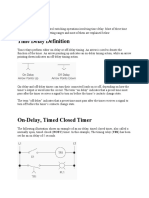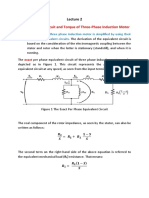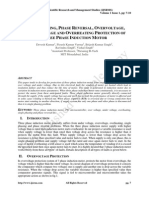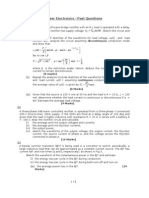Motor, Electric Traction and Electrical Control Trainer YL-195
Motor, Electric Traction and Electrical Control Trainer YL-195
Uploaded by
jhgffdfdffCopyright:
Available Formats
Motor, Electric Traction and Electrical Control Trainer YL-195
Motor, Electric Traction and Electrical Control Trainer YL-195
Uploaded by
jhgffdfdffOriginal Description:
Copyright
Available Formats
Share this document
Did you find this document useful?
Is this content inappropriate?
Copyright:
Available Formats
Motor, Electric Traction and Electrical Control Trainer YL-195
Motor, Electric Traction and Electrical Control Trainer YL-195
Uploaded by
jhgffdfdffCopyright:
Available Formats
For
Second Year
( Department of Electrical Engineering)
ROLL No: 01, 03, 04, 05, 07, 09, 11, 12, 13, 14
Batch : 12 Electrical
Department: Electrical Engineering
Subject: DC Machine
Class Advisor: Ahsanullah Memon
Supervised by: Ahsanullah Memon (Lecturer)
Complied by: Group No. 1
ELECTRICAL MACHINES LAB
DEPARTMENT OF ELECTRICAL ENGINEERING
Mehran University of Engineering and Technology SZAB Campus.
INDEX
S.NO
& DATE EXPERIMENTS
01. Introduction to Electrical Machines, and Transformer.
28-08-13
02. Verification of O.C.C of Seprately Excited DC Generator
04-09-13
03. Verification of O.C.C of Self Excited Series DC Generator.
23.09.13
04. To verify Internal Characteristics of Separately excited DC
23.09.13 Generator (Verification of Armature reaction.)
05. Verification of Characteristics of DC Shunt Generator.
24.09.13
06. Verification of Characteristics of Over Compound
24.09.13 Generator
07. Effect of Field current on back EMF & Speed of Separately
27.09.13 excited DC Motor.
08. Effect of Line resistance on Back EMF of Separately excited
27.09.13 DC Motor.
09. Effect of Load on Back EMF & Armature current of Separately
27.09.13 excited DC Motor.
10. Speed Control of DC Motor by Ward-Leonard System
5.10.2013 (Voltage Control).
11. Speed Control of DC Series motor by putting diverter in
09.10.2013 parallel to field winding.
12. Speed Control of DC Series Motor by putting diverters in
15.10.2013 parallel to armature.
Practical # 01
OBJECT :-
Introduction of Electrical Machines equipments and transformer
Equipment :-
1. DC Motor
2. DC Generator
3. Transformer
4. YL-195 Motor, Electric traction and Electrical control trainer
1. DC Motor:
CIRCUIT DIAGRAM
THEORY :-
Motors take electrical energy and produce mechanical energy. Mechanical energy can be
supplied to various types of load. The motor operating on DC supply are called DC motor. DC motors
do not operate in protected locations, they face dust, moisture, fumes and tend to get mechanical
damage. Hence, their construction is of closed type. The operation of motors is based on the principle
– when a current-carrying conductor is placed in a magnetic field, it experiences a mechanical force.
The magnitude of this force is F = BIL, and its direction is determined by Fleming's left-hand rule.
DC Machine Practical Journal | 3
Working of D.C. Motor
Suppose the conductors under N-pole carry currents into the plane of the paper and
those under S-pole carry currents out of the plane of the paper as shown in Fig.(4.1). Since each
armature conductor is carrying current and is placed in the magnetic field, mechanical force acts on it.
Referring to Fig. (4.1) and applying Fleming’s left hand rule, it is clear that force on each conductor is
tending to rotate the armature in anticlockwise direction. Speed is controlled by varying the rotor
voltage and hence the rotor current, or by varying the magnetic flux in the air gap by changing the
current in the field windings. With access to both the field and rotor windings, all DC motors offer the
facility of simple speed and torque control.
Ratings and Figure of DC Motor
Below is One of type of DC Motor named as DC Separately Excited Motor in which The
armature and field winding are electrically separate from each other and The field winding is excited by
a separate DC source.
DC Machine Practical Journal | 4
Schematic Diagram
Ratings of DC Motor (Seprately Excited)
1 Power (Pn) 120W
2 Frequency 1000 r/min
3 Voltage 110
4 Current (in amperes) 1.25A
Figure
DC Machine Practical Journal | 5
2. DC Generator:
Theory:
A generator is a machine that converts mechanical energy into electrical energy by using the
Principle of magnetic induction which is done by rotating armature which contains conductors and
move them through a magnetic field. The voltage generated by DC Generator varies from 0 to its
maximum value twice each revolution of its loop.
The construction of a DC generator is very similar to the construction of a DC motor.
The rotor consists of an electromagnet providing the field excitation. The construction of a DC
generator is very similar to the construction of a DC motor
DC Generator
Basic Components of DC Generator
1. Armature: It is structure upon which are mounted are coils that which cuts magnetic lines of
force.
2. Commutator: It is that Component of DC Generator that rectifies generated alternating current
to provide direct current output and connects the stationary output terminal to rotating
armature.
3. Brushes: Brushes make contact with the commutator to collect the current generated by
armature coil.
4. Poles are required to produce magnetic field or flux which passes through conductor of
armature coil.
DC Machine Practical Journal | 6
Ratings of DC Generator
1 Power (Pn) 120W
2 RPM 1000 r/min
3 Voltage 110
4 Current (in amperes) 1.25A
3. Transformer :
Theory:
A transformer is a device having no movable parts that transfer power from one circuit to
another circuit usually with changes values of both current and voltage. As current vary in
primary coil will creates a varying magnetic flux in the transformer's core as a result magnetic
flux vary in secondary coil. The variation in secondary coil will induces emf or voltage in
secondary coil. Transformers can link two or more electric circuits. In its simple form two
electric circuits can be linked by a magnetic circuit, one of the electric coils is used for the
creation induced voltage in the same.
Transformers have good applications in High voltage Power Transmission.
Ratings of Transformer
1 Primary Voltage 127V
2 Frequency 50 hertz
3 Secondary Voltage 50V
4 Current (in amperes) 1.25A
4. YL-195 Motor, Electric traction and Electrical control trainer: This type of panel is used in
practical such as of dc generators, motors, transformers etc. It contains equipments such as
millimeter, power supply rheostats, switches etc. A general View of this panel is shown below.
DC Machine Practical Journal | 7
Components:
3-Phase AC DC power supply
1-Phase AC power supply and Knife Switch
AC DC voltmeters and ammeters
DC Machine Practical Journal | 8
Electricity parameter tester
DC Machine Practical Journal | 9
Practical # 02
Objective:
Verification of O.C.C (Open Circuit Characteristics) of Separately Excited DC Generator.
Equipments:
Power Supply
DC Voltmeter
DC Ammeter
DC Supply
3-Phase Induction Motor
The separately excited motor has independent voltage supplies to the field and rotor windings
allowing more control over the motor performance.
Characteristics
The voltage on either the field or the rotor windings can be used to control the speed and
torque of a separately excited motor.
This curve shows the relation between the generated e.m.f. at no-load (E0) and
the field current (If) at constant speed. It is also known as magnetic characteristic or no-load
saturation curve. Its shape is practically the same for all generators whether separately or self-
excited. The data for O.C.C. curve are obtained experimentally by operating the generator at
no load and constant speed and recording the change in terminal voltage as the field current is
varied.
The O.C.C is also known as no load magnetizing characteristics. It gives relation
between generated emf on no-load and the field current when machine is driven at rated
speed. The field winding of generator is provided with separate DC Source. The Ammeter is
connected in series that will be used to read excitation current through field winding while
voltmeter is connected with armature to read generated emf.
DC Machine Practical Journal 10
Procedure:
The O.C.C. for a d.c. generator is determined and verified as follows
1. Connections are made as per the circuit diagram.
2. Disconnect the field winding of DC Generator from the machine and is separately excited
from an external d.c. source as shown in figure above.
3. Connect Ammeter with series with field winding that will read excitation current through the
field winding.
4. Connect the voltmeter across the armature that will read the emf generated by the machine
5. The generator is run at fixed speed (i.e., normal speed). The field current (If) is increased
from zero in steps and the corresponding values of generated e.m.f. (E0) read off on a
voltmeter connected across the armature terminals. On plotting the relation between E0 and
If, we get the open circuit characteristic as shown in Fig.
Connections:
DC Machine Practical Journal 11
Readings:
V 15 31 48 74 97 124 153 183
If 0.02 0.05 0.07 0.10 0.13 0.17 0.21 0.24
Eo 26 54 84 121 141 154 163 172
Conclusion:
We Observe from practical that on no loaf Generated emf was still 8V, This was due to residual
flux. And there was one point after (183V )which No load voltage (Eo) stopped increasing, that point is
called saturation point. To sum up, as the voltage was increased the generated e.m.f. (Eo) was
increases.
Open Characteristic Curve
DC Machine Practical Journal 12
Practical # 03
Object:
Verification of O.C.C of Self Excited Series DC Generator.
Equipment Used:
3-Phase AC Power Supply
3-Phase Induction Motor
Self excited series connected DC Generator
Fixed & Variable resistive loads
DC Voltmeter
DC Ammeter
Theory:
Figure below describes the characteristics of dc series generator. The curve (a) shows open
circuit characteristics, curve (b) shows internal and curve 3 indicate external characteristics of dc
series generator. When Load current is 0 the generated and terminal armature V are same, both being
due to residual magnetic field. When when load is applied, Automatic build up of V takes place from
the point when load current flows through series field winding producing additional flux aiding residual
flux.as further increase in load beyond the maximum voltage point produces sharply drooping
characteristics as shows below. The reason being the increased voltage drops and the increased
armature reaction decreased the load voltage at a much faster than increase in generated voltage
taking place by the increased load current.
DC Machine Practical Journal 13
Procedure:
1. Connect the circuit as shown in connection below. (We need to connect the feld winding across
the armature instead of connecting it to a separate supply).
2. Slowly increase the input to the prime-mover. Speed of the set will increase. Observe the
voltmeter connected across the terminals of the dc generator. Above a certain speed the voltmeter
reading starts increasing (If this does not happen reduce the prime-mover input and switch o® the
supply. Interchange the feld terminals of the generator and repeat the same procedure). By controlling
the input to the prime mover adjust the speed to the rated speed of the machine.
3. Close the main switch S. Load the generator in steps by switching ON the load and for each
case adjust the prime mover input such that the speed remains constant. Note down the load
voltage and current, feld current of the generator, armature current and voltage.
Repeat this procedure till the load current is equal to the rated current of the generator.
4. Put off all the load, open the main switch S, reduce the prime mover input and put off the AC
supply to the controller.
Discription:
Load Resistance Field Current Generated Voltage
At No load Eo ∞ 0 10
At Load 1 200 0.06 13
At Load 2 300 0.76 78
At Load 3 400 1.54 79
DC Machine Practical Journal 14
Connections:
Load 1
3 Phase AC Supply
DC Ammeter & Voltmeter
3 Phase Induction Motor
Switch Switch 2
1
Load 2
Self Excited Series Motor
DC Machine Practical Journal 15
Characteristic Curve:
Due to Satuaration Point
Eo Load 1 Load 2 Load 3
Result:
We Observe from the curve that there is certain field current after which generated voltage remain
constant even after increasing the load that point is called satuaration point.
DC Machine Practical Journal 16
Practical # 04
Object:
To verify Internal Characteristics of Separately excited DC Generator (Verification of Armature
reaction.)
Equipments:
3-Phase AC Power Supply
3-Phase Induction Motor
Regulated AC & DC Supply
DC Separately excited Generator
Variable & Fixed Resistive Loads
DC Voltmeter
DC Ammeter
THEORY :-
The load or external characteristic of a generator is the relation between the terminal voltage and load current.
The characteristic expressed the manner in which the voltage across the load varies with I, the value of load
current. The internal or total characteristic of a generator is the relation between the e.m.f actually induced in the
generator Ea and the armature current Ia. The internal characteristic of the generator, which is separately excited,
can be obtained as below:
Let:
Vt = Terminal voltage
Ia = Armature current
Ra = Armature resistance
Then,
Ea = Vt + IaRa
Ia = IL
Therefore if we add drop of armature (IaR a) to terminal voltage Vt we get actually induced e.m.f (Ea).
PROCEDURE:-
1. Make the connections according to the circuit diagram.
2. Run the generator at a constant speed and the exciting current.
3. Connect the load across the generator armature.
4. Increase the load current gradually by the help of load rheostat and note the readings of ammeters and
voltmeter.
Discription (Readings):
VDC= 100
Ia= IL
Load Eg Ia=IL
At No Load 142 0
At Load 1 (200Ω+100Ω variable) 126 0.61
At Load 2 (250Ω+150Ω variable) 111 0.85
At Load 3 (100Ω+0Ω variable) 85 1.58
DC Machine Practical Journal 17
Connections:
3 phase Power
3 phase supply
induction motor
Characteristic Curve:
Internal Characteristic Curve
DC Machine Practical Journal 18
Practical # 05
Object: Verification of Characteristics of DC Shunt Generator.
Equipments
3-Phase AC Power Supply
3-Phase Induction Motor
DC Self excited Compound Generator
DC Voltmeter
DC Ammeter
Regulated AC & DC Supply
Variable & Fixed Resistive Loads
Theory:
A generator when operated for the general operation its speed practically is constant under such
conditions it gives relationship among excitation load current and voltage. These relation when shown by the
graphs then they are called characteristics which are actually three curves.
1. Open Circuit Chacteristics
2. Internal Characteristics
3. External Characteristics
OCC show relationship between no load generated emf and field current.when generator builds up small voltage
generated emf remains constant coz it is not applied to any load. Internal Characteristics shows relationship
between on load generated emf and armature current. When generator is put on load the emf decreases due to
reduction of flux at per pole. So as obserbed in practical emf generated on no load condition is greater than
the emf generated on load. The external characteristics curve show relation between terminal voltage and load
current. As we put generator on load, the load current was decreased when calucalated this was because of
because of amount of ohmic drop.
Procedure:
1. Make connection as per given.
2. Adjust field regulator to the motor so that generator runs at its rated speed.
3. Adjust generator field regulator so that rated voltage is obtained at its terminals.
4. Gradually apply load in steps and note down readings of the load. Keep the speed constant at its rated
value by adjusting motor field regulator throughout experiment.
5. Plot the external load characteristics from the experiment.
6. Determine the armature resistance experimentally
7. Take readings of voltmeter and armature by varying the load resistance and determine average value of
armature resistance.
Precautions:
While sharting the the motor the field regulator (rhostate) must be in minimum position
DC Machine Practical Journal 19
Connections:
Seprately Excited On No load.
3 Phase DC Supply 3 Phase Induction
Motor
Regulator
Self Compund
Generator DC Ammeter and Voltmeter
DC Machine Practical Journal 20
Seprately Excited On load.
3 Phase DC Supply 3 Phase Induction
Motor Regulator
Self Compund DC Ammeter and Voltmeter Load 2 Load 1
Generator
DC Machine Practical Journal 21
Practical # 06
Object: Verification of Characteristics of Over Compound Generator
Equipments:
3-Phase AC Power Supply
DC Voltmeter
DC Ammeter
Regulated AC & DC Supply
3-Phase Induction Motor
DC Self excited Compound Generator
Variable & Fixed Resistive Loads
Theory:
If the series winding turns are so adjusted that with the increase in load current the terminal voltage
increases it is called over compound. In such case as the load current increases the series field mmf increaes and
tends to increase the flux and hence the generated voltage. The increase in generated voltage is greater than the
IaRa drop so that instead of decreasing the terminal voltage increaes. The series excitation aids the shunt
excitation. The degree of compounding depends upon the increase in series excitation with the
increase in load current.
Discription:
First we connected series winding, we observed that on no load voltage is 8V due to residual
flux as the load increases the voltage as well as current increases. Then we will observe parameters
for Shunt connected also.
Incase of Series Windings Only.
Load Eg IL
No load 8 0
Load 1 78 0.62
Load 2 94 0.88
DC Machine Practical Journal 22
On No Load: Eg is 8V due to residual Flux, Ia=0
When Load 1 is Connected as seen in connection: Putting L1 (using series winding only) Eg
Increases as well as Ia.
When Load 2 is connected as seen in connection: Putting L2 (using series winding only) Eg
increases as well as Ia.
When Parallel Component is not added
DC Machine Practical Journal 23
3 Phase Supply Voltmeter and
Ammeter
Load 1
Ammeter
Self Compund
Genrator Load 2
3 Phase Induction Motor
DC Machine Practical Journal 24
Incase of Shunt Also connected with Series Windings.
Load Eg IL
No load 8 0
Load 1 28 0.21
Load 2 89 0.83
On No load: While using both shunt ans series winding, on no load Eg increases as well as Ia.
When Load 1 is connected: Eg increases as well as Ia.
When Load 2 is connected: Eg further increases as well as Ia.
DC Machine Practical Journal 25
When Parallel Component is added
Voltmeter and
3 Phase Supply Ammeter
Load 1
Self Compund Load 2
3 Phase Induction Motor Genrator
DC Machine Practical Journal 26
Practical # 07
Objective: Effect of Field current on back EMF & Speed of Separately excited DC Motor.
Equipments
3-Phase AC Power Supply
3-Phase Induction Motor
DC Self excited Compound Generator
DC Voltmeter
DC Ammeter
Regulated AC & DC Supply
Variable & Fixed Resistive Loads
Theory: The aim of this Practical is to see the effect of field current on back emf and to observe the speed of
separately excited dc motor of DC motor speed control. The greatest advantage of DC motors may be speed
control. Since speed is directly proportional to armature voltage and inversely proportional to the magnetic flux
produced by the poles, adjusting the armature voltage and/or the field current will change the rotor speed.
The field current, If, is constant (and hence the flux density B is constant), and the armature voltage is
varied. A constant field current is obtained by separately exciting the field from fixed dc source. The flux is
produced by the field current, therefore, essentials constant. Thus the torque is proportional only to the armature
current. As we increase the Vdc of separately excited motor If increases, flux increases and back emf increases but
speed (N) decreases.
Since we know that
Eb= V-IaRa,
Increasing resistance will decrease Eb &As load is increased, armature current also increases.
DC Machine Practical Journal 27
Connections:
DC Machine Practical Journal 28
Table:
LiResistance is kept constast that is 294 whereas applied voltage is158 Volts
Vdc 15 34 51 71 100 121 149
If 0.02 0.05 0.07 0.10 0.14 0.17 0.20
Eb 63 96 107 117 121 122 123
DC Machine Practical Journal 29
Practical # 08
Object:
Effect of Line resistance on Back EMF of Separately excited DC Motor.
Equipments:
Single Phase Supply
AC/DC Converter & Regulator
DC Ammeter
DC Voltmeter
Variable Resistor
DC regulated Power Supply
Separately Excited DC Generator or Motor
Theory:
In D.C motor, supply voltage V has to overcome back e.m.f which is opposing V and also
various drops as armature resistance drop, brush drop etc. Infact the electrical work done in
overcoming the back e.m.f. gets converted into the mechanical energy developed in the armature. The
voltage equation of a d.c. motor is,
Eb= V-IaRa,
It was observed from the practical as the resistance was increased back emf was decreased this was due to that
the armature drops are inversely proportional to Baack emf.
Table:
Observed Effect of Line resistance on Eb.
As seen Eb is decreasing on decrease of RL.
VDC = 149 Volts
If = 0.2 amp.
R 294 394 494 594 694 794 894
Eb 123 111 99 89 88 78 57
DC Machine Practical Journal 30
Connections:
DC Machine Practical Journal 31
Practical # 09
Object:
Effect of Load on Back EMF & Armature current of Separately excited DC Motor.
Equipments:
Single Phase Supply
AC/DC Converter & Regulator
DC Ammeter
DC Voltmeter
Fixed Resistance
DC regulated Power Supply
Separately Excited DC Generator or Motor
Mechanical Loads
Theory:
The principle that the back e.m.f. is proportional to speed, Eb α N.
Initially When load is put on to the motor, motor slow down as a result speed of the motor and
back emf reduces. The net voltage across the armature increases. As a result when load is put on
motor, the motors carries more armature current. The motor speeds stops decreasing when the
armature current is just enough to produce torque demand by the new load.
When load on the motor is decreased, the speed of the motor tries to increase. Hence back e.m.f.
increases. This causes (V- Eb) to reduce which eventually reduces the current drawn by the armature.
The motor speed stops increasing when the armature current is just enough to produce the less torque
required by the new load.
Table:
Table (Readings):
Armatur drops/Line resistance = 174 ohms, VDC = 148 Volts & V = 157 Volts
Load Eg Ia
At No Load 138 0.13
At Load 1 124 0.18
At Load 2 111 0.25
At Load 3 94 0.33
Connections:
DC Machine Practical Journal 32
At Load 1:
DC Machine Practical Journal 33
At 2 Load:
DC Machine Practical Journal 34
At Load 3
DC Machine Practical Journal 35
Practical # 10
Object:
Speed Control of DC Motor by Ward-Leonard System (Voltage Control).
Equipments:
Single Phase Supply
AC/DC Converter & Regulator
DC Ammeter
DC Voltmeter
Fixed Resistance
DC regulated Power Supply
Separately Excited DC Generator
Separately Excited DC Motor
Theory:
This method of Ward Leonard system is one of favorable method for DC Motor speed control.
In this process the speed of motor is controlled by armature from 0 to load base speed. On separately excited
flux is constant and do not depend on load (N constant) (V constant). If you require higher motor speed Field
current is lowered in this process as a result torque reduces. This system provides constant torque below base
speed, rated horsepower (and torque) at base speed, and constant horsepower (hence variable torque) above base
speed. In ward Leonard system speed of motor is controlled in both directions
Procedure:
Give 3 Phase supply to induction motor.
Connect remaining terminal in star connection.
Attach Motor shaft to Dc generator.
Provide Separately Dc TO DC generator to be excited. (Sperately DC canbe achieved from
AC/DC Regulated panel
One Ac supply is given to Ac/Dc regulated panel, which gives us regulated supply.
Connect Voltmeter to A1 and A2 to measure Eg.
Dc supply generated from generator is given to Dc motor and In between them ammeter is
connected to measure IL.
Separately Dc is supplied to Dc motor to be separately excited.
Volt meter is connected across A1 and A2 of Dc motor to measure Eb.
Fixed resistor is connected in between that supply and B1/B2.
Ammeter is also connected between separately excited winding of Dc motor and Dc supply.
Dc voltage across B1 and B2 of Dc generator varied to see its effect on Eg , Eb, IL and If.
As Vdc increases, all Eg, Eb, IL and If and speed also increases.
DC Machine Practical Journal 36
Connections:
Table:
VDC 0 12 29 46 61 76
Eg 5 20 49 78 102 121
(Generator)
IL 0.09 0.10 0.11 0.11 0.12 0.12
(Motor)
If 0 0.02 0.04 0.06 0.09 0.12
(Generator)
N 50 75 100 150 175 200
(Speed)
Conclusion: Flux of series and shunt depend on load. it was seen speed increases with increase in Eg
means supply of DC motor.
DC Machine Practical Journal 37
Practical # 11
Object:
Speed Control of DC Series motor by putting diverter in parallel to field winding.
Equipments:
Equipments used in practical were:
Series DC Motor
Loads (DC Generator & 3-Ph Induction Motor)
Variable Resistor
DC Ammeter & Voltmeter
Theory:
In this method variable resistance (called field diverter) is connected parallel with series field
winding. The main reason to do this is to shunt some portion of the line current from the series field
winding, as a result weakening the field and increasing the speed. The lowest speed obtainable is that
corresponding to zero current in the diverter). The lowest speed obtainable is the normal speed of the
motor. Consequently, this method can only provide speeds above the normal speed. The series field
diverter method is often employed in traction work.
Procedure:
Apply Vdc is applied across A1 and B2 (VDC Of motor is constant)
Connect Ammeter between supply and A1 B2
Connect A2 to B1 to connect field winding in series
Apply Load through the shaft of motor
Attach diverter across the field winding to control the speed of DC Motor. Here we used Variable
resistor as a diverter
DC Machine Practical Journal 38
Connections:
Conclusion:
It was seen that when the field diverter resistance was increased then the flux were increasing
and due to increase in flux the speed was decreasing, as are inverse proportional to each other.
DC Machine Practical Journal 39
Practical # 12
Object:
Speed Control of DC Series Motor by putting diverters in parallel to armature.
Equipments:
Series DC Motor
Loads (DC Generator & 3-Ph Induction Motor)
DC Ammeter & Voltmeter
Variable Resistor
Theory:
We connect variable resistance or armature diverter is connected in parallel with the armature Line current
is shunt by the diverter that results in reducing the armature current. Now for a given load, if Ia Is decreased, the
flux must increase Since, the motor speed is decreased. By adjusting the armature diverter, any speed lower than
the normal speed can be obtained.
Procedure:
Give separately DC Supply to A1 & B2 terminals of DC Series connected Motor.
Connect Ammeter in between them to measure Armature Current.
Connect Variable resistor in Parallel/Shunt to Armature A1 & A2.
Connect Loads to the shaft of DC Series Motor.
Vary Resistance to see its effect on armature current.
Connections:
DC Machine Practical Journal 40
Conclusion:
The speed of DC motor was decreasing with the increase of resistance in armature
diverter. AS the resistance increase the speed will decrease because the current will then go through
the armature & Ia is increased due to load then the flux increases & speed will decrease as they have
inverse relation to each other.
The End
Thank you
DC Machine Practical Journal 41
You might also like
- Test Your Motor Control IQDocument1 pageTest Your Motor Control IQboy2959100% (1)
- Acuson Aspen User ManualDocument248 pagesAcuson Aspen User Manualemail.maqsood6783No ratings yet
- Microcontroller Project Report 2016Document42 pagesMicrocontroller Project Report 2016M SarkarNo ratings yet
- Digital Control Systems: Unit - I Sampling and ReconstructionDocument4 pagesDigital Control Systems: Unit - I Sampling and Reconstructionvamkrishna33% (3)
- ETO EXAM Notescover 1Document2 pagesETO EXAM Notescover 1Tun Lin NaingNo ratings yet
- Time RelaysDocument20 pagesTime Relaysmazen banatNo ratings yet
- Electronic SCR & UJTDocument18 pagesElectronic SCR & UJTnfahmilahNo ratings yet
- Insulation Class of MotorDocument1 pageInsulation Class of MotorDEADMANNo ratings yet
- Ac DC PWMDocument6 pagesAc DC PWMIrfan AliNo ratings yet
- U MG MG Myat PIC BasicDocument58 pagesU MG MG Myat PIC BasicJenny Sdd100% (1)
- What Is The Use of Choke in Florescent TubesDocument7 pagesWhat Is The Use of Choke in Florescent Tubessumanta1981100% (2)
- 5 Simple DC Motor Speed Controller Circuits ExplainedDocument18 pages5 Simple DC Motor Speed Controller Circuits Explainedlasser22832165No ratings yet
- Draw The Block Diagram of Electric Drive SystemDocument9 pagesDraw The Block Diagram of Electric Drive SystemcoolkannaNo ratings yet
- Implementation of A Microcontroller Based 5 KVA Automatic Voltage StabilizerDocument8 pagesImplementation of A Microcontroller Based 5 KVA Automatic Voltage StabilizerMawunyo100% (1)
- Simple Water Level IndicatorDocument1 pageSimple Water Level IndicatorhiteshatrescribdNo ratings yet
- Type Irxm: Circulating Current RelayDocument7 pagesType Irxm: Circulating Current RelayThejaswini ArNo ratings yet
- ETR All Questions and Answers (UKKG) - 07feb2024Document26 pagesETR All Questions and Answers (UKKG) - 07feb2024khinmaungkywe2211No ratings yet
- Modeling and Simulation of Bidirectional Ac-Dc Power ConverterDocument4 pagesModeling and Simulation of Bidirectional Ac-Dc Power ConverterKalyan Reddy AnuguNo ratings yet
- Three Point and Four Point StarterDocument7 pagesThree Point and Four Point Starterkaran nirmala gajanan shindeNo ratings yet
- DC Motor - Drive 2019Document80 pagesDC Motor - Drive 2019ali ramadanNo ratings yet
- Phase Controlled Ac To DC ConvertersDocument41 pagesPhase Controlled Ac To DC ConvertersTharakaKaushalyaNo ratings yet
- Chapter 4 PDFDocument11 pagesChapter 4 PDF김채현No ratings yet
- Voltage Doubler ADocument2 pagesVoltage Doubler AErole Technologies Pvt ltd Homemade EngineerNo ratings yet
- Problems Chapter 5 1Document7 pagesProblems Chapter 5 1Siva KumarNo ratings yet
- The Equivalent Circuit and Torque of Three-Phase Induction MotorDocument11 pagesThe Equivalent Circuit and Torque of Three-Phase Induction Motorعمر تاليونNo ratings yet
- PPTDocument24 pagesPPTRaj VaghelaNo ratings yet
- 1 Circuit TheoryDocument34 pages1 Circuit TheoryFaris Abd HalimNo ratings yet
- 12v Automatic Battery Charger With Auto-CutoffDocument13 pages12v Automatic Battery Charger With Auto-CutoffGopolang Jerome TaeyeleNo ratings yet
- DCMTDocument37 pagesDCMTGloria HolcombNo ratings yet
- Car Parking Guard Circuit Using Infrared SensorDocument5 pagesCar Parking Guard Circuit Using Infrared SensorIshan Kothari100% (4)
- Door Monitor ProjectDocument4 pagesDoor Monitor Projectlekhs_tim10% (1)
- 12V To 24V DC DC ConverterDocument4 pages12V To 24V DC DC ConverterDavid Arrata ParralesNo ratings yet
- Automatic Water Level Controller Cum IndicatorDocument46 pagesAutomatic Water Level Controller Cum IndicatorPrasanna Dhayalamoorthy50% (2)
- 2008CCS13 Root LocusDocument100 pages2008CCS13 Root LocusMarde Joy MercadoNo ratings yet
- Sri Jayachamarajendra College of EngineeringDocument13 pagesSri Jayachamarajendra College of EngineeringFernando Desengkie SangmaNo ratings yet
- TTL LOGIC Family - Hariram-1Document16 pagesTTL LOGIC Family - Hariram-1Hari RamNo ratings yet
- Motor Control Circuits ReportDocument23 pagesMotor Control Circuits ReportJuliana Kaitleen ModrigoNo ratings yet
- Construction and Working of 3 Phase Induction MotorDocument3 pagesConstruction and Working of 3 Phase Induction MotorArdyas Wisnu BaskoroNo ratings yet
- Experiment 12 The Universal Motor ObjectiveDocument5 pagesExperiment 12 The Universal Motor ObjectiveFahad IbrarNo ratings yet
- EC 307 Power Electronics and Instrumentation Lecture Notes, Module 6Document21 pagesEC 307 Power Electronics and Instrumentation Lecture Notes, Module 6vpzfaris100% (1)
- Contactor - Design and ConstructionDocument8 pagesContactor - Design and ConstructionNur YasinNo ratings yet
- Single Phasing, Phase Reversal, Overvoltage, Under Voltage and Overheating Protection of Three Phase Induction MotorDocument4 pagesSingle Phasing, Phase Reversal, Overvoltage, Under Voltage and Overheating Protection of Three Phase Induction MotorIJSRMS Journal100% (1)
- "Clap Switch": Submitted byDocument10 pages"Clap Switch": Submitted byKrishna Kumar SinghNo ratings yet
- E Adjustable 3-Phase Power Supply 0-450V 2ADocument1 pageE Adjustable 3-Phase Power Supply 0-450V 2AMasoNo ratings yet
- Electrical Ciruit Analysis PDFDocument582 pagesElectrical Ciruit Analysis PDFMohammed SabeelNo ratings yet
- Power ElectronicsDocument83 pagesPower ElectronicsSreekanth SurendrenNo ratings yet
- Electro-Pneumatics Presentation Slide July 2019Document49 pagesElectro-Pneumatics Presentation Slide July 2019Yeshi UchihaNo ratings yet
- Power Electronics Past QuestionsDocument8 pagesPower Electronics Past QuestionsSam MaosaNo ratings yet
- Load Controll Using DTMFDocument13 pagesLoad Controll Using DTMFTejas BhoiteNo ratings yet
- Separately Excited, Shunt and Compound DC Generator: AsdfsdfsdfDocument19 pagesSeparately Excited, Shunt and Compound DC Generator: AsdfsdfsdfJhi Ghi RawringNo ratings yet
- Solved Problems To Chapter 09Document4 pagesSolved Problems To Chapter 09REjosh BonifacioNo ratings yet
- Ee 591 Machine 2 PDFDocument39 pagesEe 591 Machine 2 PDFPrabhat Kumar SahuNo ratings yet
- SCR Triggering MethodsDocument17 pagesSCR Triggering MethodssriNo ratings yet
- DC Generator LectureDocument70 pagesDC Generator LectureSmirnov ArtaéévNo ratings yet
- Gujarat Technological University: Electrical System ComponentsDocument2 pagesGujarat Technological University: Electrical System ComponentsDarshit KotadiyaNo ratings yet
- Analogue Electronics Iii NoteDocument49 pagesAnalogue Electronics Iii Noteibrahimisahliman7874No ratings yet
- ProtectionDocument43 pagesProtectiongeofrey fungoNo ratings yet
- Electrical Machine 7-26-2016Document94 pagesElectrical Machine 7-26-2016Engr. Raheel khanNo ratings yet
- Machine Based Experiments Lab Report-1 Name: Karthickeien E BY: CH - EN.U4CCE21024 Group: A TopicDocument14 pagesMachine Based Experiments Lab Report-1 Name: Karthickeien E BY: CH - EN.U4CCE21024 Group: A TopicKartheepan KaNo ratings yet
- Lectures Notes of DC Machines For Met Students - 031136Document26 pagesLectures Notes of DC Machines For Met Students - 031136geraldinkougoum04No ratings yet
- GeneratorsDocument95 pagesGeneratorsRaja RamachandranNo ratings yet
- Astm D6392 23Document2 pagesAstm D6392 23ailennoraliNo ratings yet
- FS-521 A0gyDocument79 pagesFS-521 A0gyMiroslav TrundaNo ratings yet
- DaleelTeq Internship - Contract - Experience Letter 2006 - 2007Document1 pageDaleelTeq Internship - Contract - Experience Letter 2006 - 2007Ahmed M. Ibrahim El-TahirNo ratings yet
- Literature Review On Impact of Monetary Policy On Economic Growth in NigeriaDocument13 pagesLiterature Review On Impact of Monetary Policy On Economic Growth in Nigeriac5sd1aqjNo ratings yet
- DB Managment Ch9Document4 pagesDB Managment Ch9Juan Manuel Garcia NoguesNo ratings yet
- Lec 3Document52 pagesLec 3Leeladhar ChourasiyaNo ratings yet
- Bergkamp EquipmentInnovationsfromBergkampDocument23 pagesBergkamp EquipmentInnovationsfromBergkampLuis Jorge Nahle OrtizNo ratings yet
- Toyota Kirloskar Motor PVT LTD: TKM-036, Group - ADocument1 pageToyota Kirloskar Motor PVT LTD: TKM-036, Group - ABasava RajNo ratings yet
- Science, Technology and SocietyDocument18 pagesScience, Technology and Societyelizabeth bernalesNo ratings yet
- EN2 Q1 Module-2 PDFDocument12 pagesEN2 Q1 Module-2 PDFSalve SerranoNo ratings yet
- Instruction - VCC 424617 1Document7 pagesInstruction - VCC 424617 1Piotr BystryNo ratings yet
- 850 Purchase Order: ANSI ASC X12 Version 4010Document47 pages850 Purchase Order: ANSI ASC X12 Version 4010muddisetty umamaheswarNo ratings yet
- H2 EmbrittlementDocument57 pagesH2 EmbrittlementrodneyrlrNo ratings yet
- Buku Saku CodinganDocument4 pagesBuku Saku CodinganArdian JuliantoNo ratings yet
- Readvert MLM 23.2023.24 ToiletsDocument347 pagesReadvert MLM 23.2023.24 ToiletsNeoNo ratings yet
- Getting Connected: Larry L. Peterson and Bruce S. DavieDocument140 pagesGetting Connected: Larry L. Peterson and Bruce S. Davieprasath67No ratings yet
- PPL Bolt Installation TemplateDocument1 pagePPL Bolt Installation TemplateamirfazelNo ratings yet
- Proof Bachelor Medium Is EnglishDocument1 pageProof Bachelor Medium Is Englishrashi kumawatNo ratings yet
- Dell's Path To A Sustainable Competitive AdvantageDocument23 pagesDell's Path To A Sustainable Competitive AdvantageAaron Blackburn100% (2)
- Ficha Técnica - DynoMiner Advanced (Inglés)Document2 pagesFicha Técnica - DynoMiner Advanced (Inglés)Pedro Ramos PAchecoNo ratings yet
- PAG 03.1 - Determination of ResistivityDocument3 pagesPAG 03.1 - Determination of ResistivityjmsonlNo ratings yet
- ĐỀ DỰ BÁO WRITING TASK 2 - QUÝ 2 2023Document3 pagesĐỀ DỰ BÁO WRITING TASK 2 - QUÝ 2 2023tranmee05No ratings yet
- Rural Poverty in The United States (PDFDrive)Document534 pagesRural Poverty in The United States (PDFDrive)Big AllanNo ratings yet
- Let's Learn To Knit: With A Pattern StitchDocument16 pagesLet's Learn To Knit: With A Pattern StitchAncu AncaNo ratings yet
- Smartboardmanual PDFDocument56 pagesSmartboardmanual PDFCostelas CristianNo ratings yet
- Sp20so - La20s51b - Samsung - TFT-LCD TVDocument28 pagesSp20so - La20s51b - Samsung - TFT-LCD TVmiguel197234100% (1)
- Re Polemis and FurnessDocument37 pagesRe Polemis and FurnessBaguma Patrick RobertNo ratings yet
- Novack_Transportation A Global Supply Chain Perspective_10e_PPT_Ch-01Document37 pagesNovack_Transportation A Global Supply Chain Perspective_10e_PPT_Ch-01c8sp9xc22cNo ratings yet
- Narayan Murthy K.V. KamathDocument14 pagesNarayan Murthy K.V. KamathKapil NalangNo ratings yet

























































































